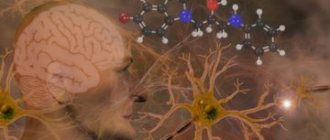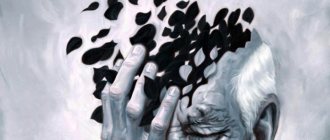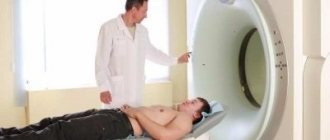Dementia with Lewy bodies (DLB) is a progressive neurodegenerative disease, most often onset in old age and manifested by increasing cognitive decline, parkinsonian symptoms, psychotic disorders and autonomic dysfunction. The true scientific history of DTL begins in the late 70s of the last century. It is associated with the name of the Japanese researcher K. Kosaka, who described several patients with dementia in whom Lewy bodies were found in the cerebral cortex at autopsy. In connection with DLB, one cannot help but recall F. Lewy himself, the famous German pathologist, who in the 30s of the last century, fleeing the Nazis, moved to the USA. He made the main discovery of his life in 1912 at the age of 27, working in Breslau (Wroclaw), describing eosinophilic inclusions in brain neurons in patients with Parkinson's disease. F. Lewy discovered intracellular inclusions in the motor nucleus of the vagus nerve and Meynert's nucleus, but not in the substantia nigra, the lesion of which is currently associated with the development of major motor disorders. This task was completed by another young scientist - our compatriot K.N. Tretyakov, who in 1917, while on an internship at the Salpêtrière clinic in Paris, described similar inclusions in the cells of the substantia nigra and proposed calling them “Lewy bodies.”
Etiology
As with AD3, most cases of DLB are sporadic; however, it appears that familial cases are more common in DLB than in AD or vascular dementia. Approximately half of patients with DLB have one or more first-degree relatives with dementia or parkinsonism. In familial cases of DLB, clinical polymorphism is observed, which complicates medical genetic analysis. Only in a relatively small proportion of familial cases of DLB, genetic mutations were identified: triplication of the synuclein gene on chromosome 4, mutations in the LRRK2 gene on chromosome 12, gene changes on the short arm of chromosome 2 (2q35-36), the functional purpose of which remains unclear.
Neuromorphology
Macroscopically, in most patients with DLB, as in many other neurodegenerative diseases, diffuse brain atrophy is detected with expansion of the cortical grooves and lateral ventricles, although on average it is less pronounced than in AD.
The development of dementia in DLB is associated with a degenerative process in the neocortex and limbic cortex, primarily in the anterior cingulate, parahippocampal gyrus, frontal and parietal cortices. As modern methods of functional neuroimaging show, already at an early stage there is a decrease in the function of the occipital cortex, which can serve as one of the differential diagnostic signs distinguishing DLB from AD. At the same time, atrophy and microscopic signs of degeneration, including Lewy bodies, in the occipital cortex are very moderately expressed. Thus, dysfunction of the occipital cortex, which may be associated with the early development of visuospatial impairment, appears to be associated with impaired neurochemical processes (eg, cholinergic denervation). The development of parkinsonism, observed in the majority of patients with DLB, is associated with the involvement of the substantia nigra and striatum in the degenerative process, and sleep disorders with damage to brain stem structures. The development of autonomic dysfunction is explained both by damage to the stem nuclei and by the involvement of peripheral autonomic structures, which already at an early stage of the disease leads to autonomic denervation of the heart.
Clinic
The range of clinical manifestations of DLB is very wide and includes cognitive, psychotic, motor disorders, autonomic dysfunction, sleep and wakefulness disorders. Cognitive decline is an obligate manifestation of DLB. Most cases of DLB are characterized by a unique neuropsychological profile, in which subcortical and cortical disorders are intertwined. At the early stage, disorders of the neurodynamic and regulatory type dominate, the leading of which are attention disorders, and both concentration and stability of attention suffer. DLB is also characterized by the early and rapid development of visuospatial impairments, which are one of the main “calling cards” of the disease.
At first, difficulties in performing tests are explained by a violation of attention, planning and execution of complex constructive tasks, and only partly gnosis. But as the disease progresses, disorders associated with dysfunction of visual associative pathways quickly appear. Over time, errors in visual recognition of objects, familiar objects, and finally close relatives appear. Moreover, self-identification also suffers - seeing his reflection in the mirror, the patient (usually in the advanced stages of DLB) mistakes him for another person (mirror symptom). Violation of regulatory (frontal) and visuospatial functions is one of the main prerequisites for the early appearance of visual hallucinations. In this case, memory remains more intact and is characterized not by a defect in memorization, consolidation and storage, but rather by a violation of the search and reproduction of traces, which is associated with dysfunction of the frontal parts and the relative intactness of the medial parts of the temporal lobes. Often, relatives are surprised to hear from a patient in moments of enlightenment a story about the events of a past life with details that they themselves have long forgotten.
Another characteristic feature of the mental status is fluctuations, characterized by transient episodes of decreased attention and activity with unspontaneity, unresponsiveness, and sometimes confusion. Such episodes of deterioration can last from several minutes to several hours and are often mistakenly regarded as manifestations of cerebrovascular insufficiency or as an epileptic phenomenon. Fluctuations in mental status also occur in other forms of dementia - vascular dementia or AD, but only in DLB they occur at an early stage of the disease. With DLB, longer-term fluctuations often occur, characterized by the presence of “bad” and “good” days (“second-order” fluctuations) or multi-day episodes of decompensation of the main manifestations of the disease (“third-order” fluctuations). Episodes of decompensation are often the result of inadequate therapy, dehydration, intercurrent illnesses, overheating, but sometimes they also occur spontaneously. In severe cases, they can result in death; in milder cases, they can result in restoration of the previous functional state. But most often, recovery is partial, which moves the patient “one step higher” in the progressive course of the disease.
Psychotic disorders are another typical, diagnostically important feature of DLB, which often has a dramatic impact on the subsequent course of the disease. Sometimes visual hallucinations, which are considered the most characteristic variant of psychotic disorders in DLB, appear already in the prodromal phase of the disease, when there is still no disturbance in daily activities that allows one to diagnose dementia. The spectrum of psychotic disorders in DLB includes, along with visual hallucinations, the so-called extracampal phenomena (feelings of the presence of a stranger or someone passing by), hallucinations of other modalities (auditory, tactile, somatic), illusions, delusional syndromes (often related in content to hallucinations). ), identification disorder syndromes (for example, Capgras syndrome), delirium.
The spectrum of psychopathological disorders should be supplemented by anxiety and depression, which often appear already at the prodromal stage of the disease, but persist at later stages, as well as such conditions as apathy, agitation, disinhibition, which, as a rule, appear at a later stage of the disease, significantly complicating nursing.
Motor disorders in DLB are characterized by symptoms of parkinsonism. In the early stages, extrapyramidal pathology occurs only in 50% of patients and is often represented by relatively mild symptoms. This often misleads a neurologist if he superficially examined the patient and did not pay attention to pronounced cognitive and neuropsychological disorders. As a result, he mistakenly diagnoses the early stage of PD and, in accordance with this, prescribes dopamine agonists, anticholinergics, etc., which can provoke psychotic disorders in this category of patients. Next, the patient is transferred to a psychiatric institution, where he is prescribed antipsychotics for psychosis, the use of which even in minimal doses in patients with DLB can lead to a sharp deterioration of the condition such as an akinetic crisis, ending in death in at least a third of patients.
As the disease progresses, the incidence of extrapyramidal symptoms increases to 80%. Parkinsonism in DLB is characterized by a more frequent left-sided onset, early development of axial disorders (hypomimia, postural instability with frequent falls, early walking impairment with freezing, truncal bradykinesia, camptocormia, dysphonia or dysarthria). Disturbances in sleep and wakefulness can manifest themselves in patients with DLB long before the appearance of other symptoms of the disease. This primarily refers to behavioral disorder (“psychomotor agitation”) during the rapid eye movement sleep phase. Such disturbances may precede other manifestations of the disease by several decades. Another common symptom is daytime sleepiness.
The early development of autonomic dysfunction is another of the most characteristic manifestations of DLB, associated with damage to the stem autonomic structures, the lateral horns of the spinal cord, and the peripheral autonomic system. The most common autonomic manifestations are neurocardiovascular instability with orthostatic hypotension and a tendency to faint, neurogenic urinary disorders (frequent imperative urination, nocturia, subsequent partial urinary retention or incontinence), gastrointestinal dysfunction (gastroparesis, constipation or diarrhea).
Prevention and treatment
Preventative measures for Lewy body dementia are the same as for Alzheimer's disease. A healthy lifestyle, proper nutrition, mental and physical activity, and giving up alcohol and smoking protects against the appearance of age-related diseases.
When treating, it is important to ensure correct diagnosis and distinguish dementia with Lewy bodies from its other forms, since these diseases require fundamentally different treatments. Drugs used for other forms of dementia and Parkinson's disease are contraindicated. Antipsychotic drugs, the so-called “neuroleptics”, do not eliminate psychotic disorders, do not provide a positive effect, but additionally increase movement disorders - so much so that death is possible. The use of drugs for parkinsonism is also unacceptable: they increase visual hallucinations and can provoke a delusional state and rapid deterioration of cognitive functions.
Thus, for dementia with Lewy bodies, mainly supportive therapy is used. It is important for the patient to provide a bright, positive environment and control his emotional state. It is advisable to use techniques that will help improve orientation in time and space (place clocks, large calendars, navigation signs, and other “tips” in the field of view). It is important to adhere to a daily routine, conduct classes aimed at strengthening memory and preserving other cognitive functions, and frequently communicate with the patient. Physiotherapy can be used as part of supportive treatment: it improves both the emotional and physical condition of the patient.
Order a visit from a gerontologist. Experienced doctors. Treatment in a hospital or at home. 24-hour service in Moscow and the region. Professional, anonymous, safe.
- Online consultations about dementia
- Factors that provoke dementia
- Dementia with Lewy bodies
- Psychoses in old age
- Age-related personality changes
- Treatment of depression in the elderly
- Is it possible to stop senile dementia?
- Treatment of senile dementia
- Dementia treatment
- Symptoms of Alzheimer's disease
- Drug therapy for patients with dementia
- Diagnosis of dementia
- Manifestation of Alzheimer's disease
- Types of dementia
- Parkinson's disease
- Hallucinations and delusions
- Vascular dementia
- Psychodiagnostics of elderly patients
- Treatment options for Parkinson's disease
- Early diagnosis of mental disorders in older people
- Senile aggression: why does it occur, what to do with it?
- Alcoholic dementia
- Mental disorders in old age
- Pick's disease
- Risk factors for dementia
Diagnostics
Today, diagnosis is based on the analysis of the entire complex of clinical signs and the results of neuropsychological testing, taking into account, in some cases, the results of instrumental research methods. In favor of DLB, in the presence of a characteristic clinical picture, is the absence of pronounced vascular or other changes on CT or MRI that better explain the clinical picture.
In this case, moderate or severe diffuse cerebral atrophy with a few lacunar foci and/or moderate periventricular leukoaraiosis is allowed. The severity of cerebral atrophy and especially hippocampal atrophy in DLB may be significantly lower than in AD, even with comparable severity of dementia.
2. Reasons
Lewy bodies are special intracellular formations in neural tissue, structurally and biochemically complex: they consist of proteins, polysaccharides and other compounds, have a nucleus, fibril processes, etc. Based on their predominant localization, such formations are divided into two types: in some cases, Lewy bodies are found predominantly in the deep parts of the brain, in others (cortical type) they are concentrated in the frontotemporal cortex. Specific disturbances are also identified in the balance of neurotransmitters - substances that regulate the electrochemical activity of the brain and are responsible for the conduction of nerve impulses. Typical Alzheimer's and/or Parkinsonian changes are also present, which leads to the development of a polymorphic, difficult to differentiate clinical picture. And vice versa: in cases of pronounced Alzheimer’s and Parkinson’s diseases, Lewy bodies are often detected pathomorphologically.
However, the answer to the main questions is which factors “trigger” the neurodegenerative process and which ones – the formation of Lewy bodies; why women get sick twice as often as men; what specifically determines the manifestation of DLB mainly after 60 years of age is not known yet.
Visit our Neurology page









